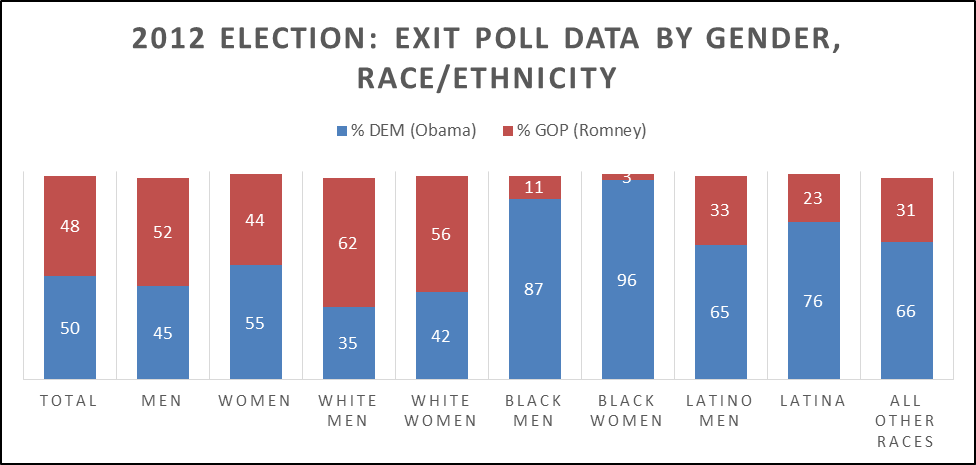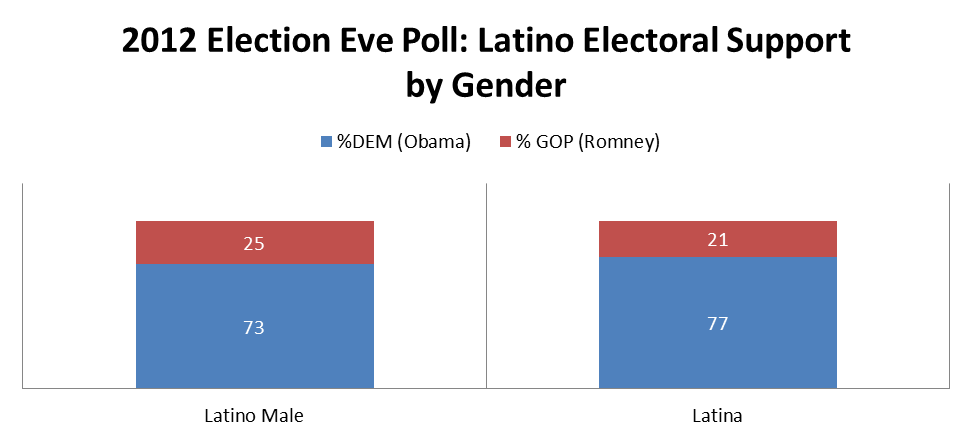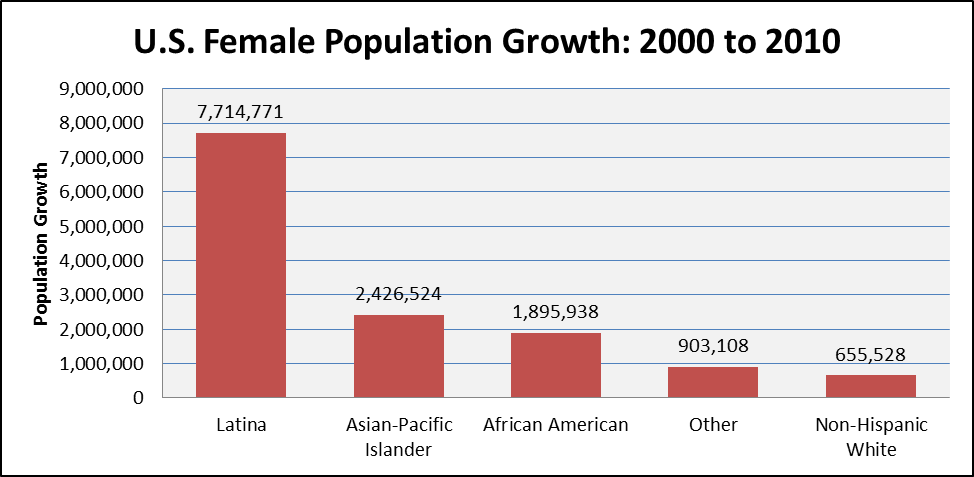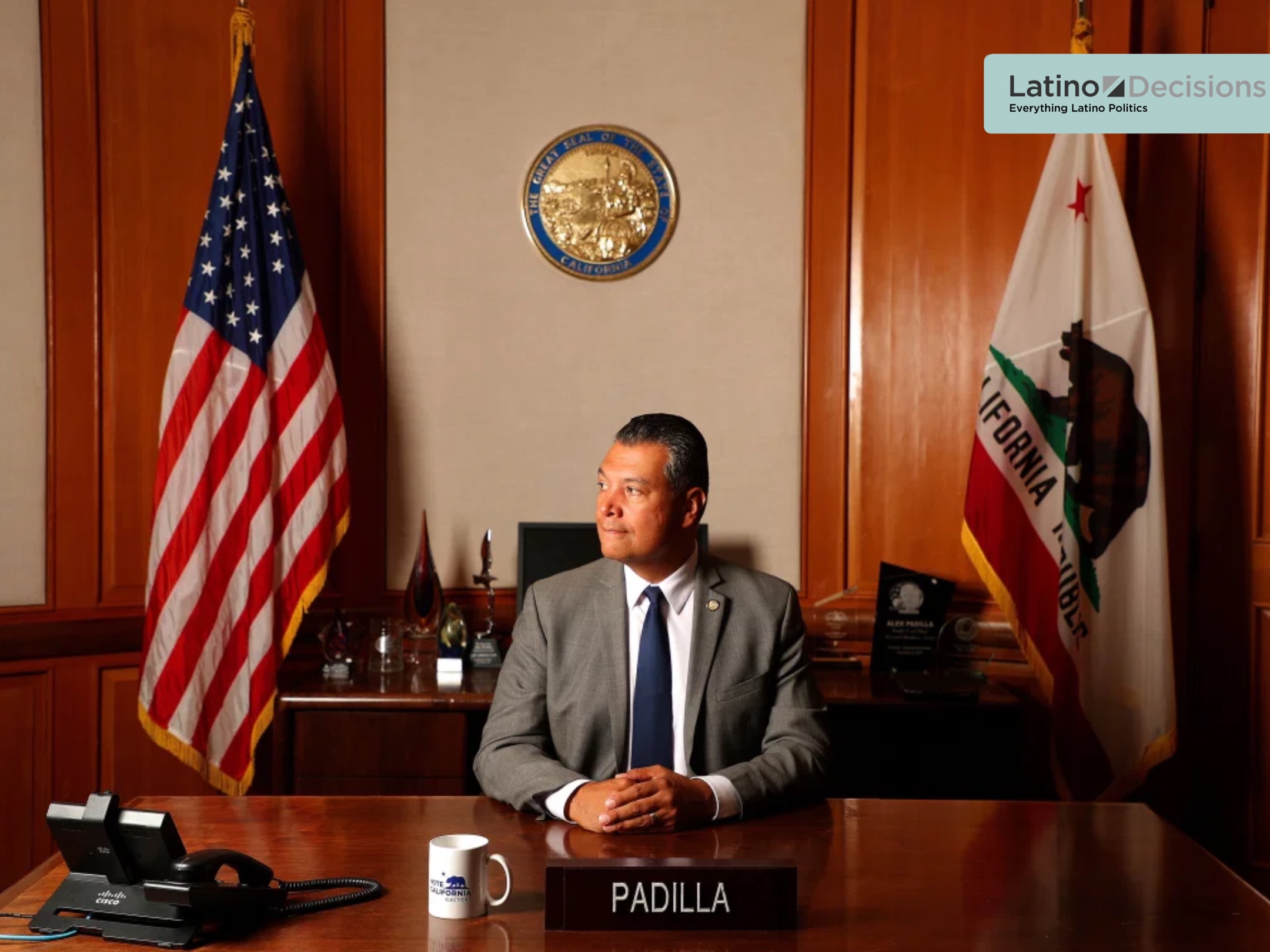Women and Latinos in the U.S. are both attracting a lot of political attention, especially after their impressive electoral impact in the last few elections. We hear about the potential “Women’s vote” or the mention of the important gender gap in U.S. politics, which is the difference between men and women’s support for the winning candidate. In the 2012 election, 55% of women supported the winning candidate President Obama (CNN). The 2012 gender gap of 10 points was slightly lower than the historic 11 point partisan gender gap for President Clinton in 1996 (CAWP).

The modern gender gap also includes women voting at higher rates than the men, which motivates both political parties to strategically appeal to the “women’s vote”. The Republican Party is hoping to reduce the size of the partisan gender gap for Democratic candidates in the upcoming 2014 midterm elections. The GOP strategically offered an all-woman official response to the state of the union with Rep. Cathy McMorris (WA) in English and Rep. Ileana Ros-Lehtinen (FL) with a Spanish response.
We typically only focus on this modern gender gap in terms of the white majority population, however we also hear about the important impact of the “Latino vote.” President Obama won re-election in 2012 with the help of 75 percent support among Latinos (ImpreMedia-Latino Decisions Election Eve Poll). The growing Latino population can significantly influence the direction of future elections, since they generally provide a slim majority of voter support to the Democratic Party and a small level of voter support to Republicans. However, both major political parties are unsure how to successfully court the Latino vote, especially since they do not understand the diversity of this growing population.
It is also important for us to discuss the important “minority women’s vote”. The modern U.S. partisan gender gap is now reinforced by the political behavior of racial/ethnic minority women. In fact, black women and Latina voters overwhelmingly supported President Obama, by 9 to 11 points respectively, which was greater than their male counterparts (CNN). This partisan gender gap for blacks and Latinas even exceeded the gender gap for whites, which was 7 points. The ImpreMedia-Latino Decisions Election Eve Poll demonstrated the 2012 depth of Latina Democratic support with Latina voters preferring President Obama to Romney, 77% to 21% or a 56 point gap.

My recent book, The Latino Gender Gap in U.S. Politics (2014), delves deeper into the complex differences in voter gender and race/ethnicity for Latino political behavior and attitudes. There are many unanswered questions over the possible gender differences in Latino political participation rates, where females are currently participating in politics at higher rates than their male counterparts. Latinas also demonstrate distinctive political attitudes compared to their male counterparts, which has helped them become the central agents of Latino political participation.
In the book, I compare the size and direction of the Latino gender gap. I expand on previous research, by exploring the influence of gender on Latino political attitudes and participation, especially for different Latino generations in the U.S. First, I incorporate the gendered analysis of migration and political incorporation to examine the varied experiences for the Latino community. Much of the growing foreign born population is made up of female immigrants, who are migrating to the U.S. at higher rates than men (NALEO). This growing presence of Latina immigrants can significantly influence Latino political participation in the United States.

Next, I examine the diverse experiences of Latinos in the most recent political environment. In the book, I use national public opinion datasets and focus group data to examine the gender differences in Latino political attitudes and behavior for the 2004, 2008, and 2012 presidential elections in the U.S. Explanations of the gender gap phenomenon come from the gendered experiences of immigrant incorporation and socialization, which include varied gender experiences with socio-economic change and changing political attitudes that are experienced by later generations.
There are a number of political implications for the gender differences in Latino politics. I argue it is important to focus on Latinas as catalysts of political change, since they are perceived to be the key to mobilizing Latino families and communities. As Latinas continue to exhibit significant gender differences in their political attitudes and behaviors, they will attract more political authority and voting power that can dramatically influence American politics.
Latino political organizations and the major political parties are realizing the political impact of gender differences in Latino political participation. NALEO, the National Organization of Latino Elected/Appointed Officials, is currently developing a “Latina Strategy” for their naturalization and get-out-the vote efforts, which will include a campaign focused on mobilizing Latinas.
In addition, there are political organizations that are focusing on a Latina strategy to increase the election of Latinos. LatinasRepresent Project is a joint initiative of Political Parity and the National Hispanic Leadership Agenda working to advance Latinas’ political representation. This project was launched nationally last week in Denver, Colorado.
I will follow-up with this overview of the book in a series of future posts on the Latino gender gap in U.S. politics. The posts will focus on the gender differences in Latino political participation, partisanship and political ideology, and public policy views.
Christina Bejarano is an Associate Professor of Political Science at the University of Kansas. Her book entitled The Latino Gender Gap in U.S. Politics (2014) was recently published by Routledge Press.
The commentary of this article reflects the views of the author and do not necessarily reflect the views of Latino Decisions. Latino Decisions and Pacific Market Research, LLC make no representations about the accuracy of the content of the article.


